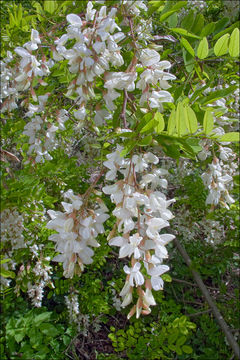Image of black locust

Description:
Slo.: navadna robinija, neprava akacija - Robinia pseudacacia, Robinia pseudo-acacia L. - Habitat: mixed wood on alluvial terrace edge, Fagus sylvatica. Pinus sp., Picea abies, Corylus avellana, Ostrya carpinifolia dominant trees; calcareous ground, sunny place, elevation 400 m (1.300 feet); average precipitations ~ 3.000 mm/year, average temperature 8-10 deg C, alpine phytogeographical region. Comment: Robinia pseudoacacia is a two-faced tree of Europe imported from America in 1601, which is now common and already naturalized. It can grow up to 25 m height. On the one side it is quite an aggressive invasive species, horribly thorny and lightly poisonous. Thorns, developed from bracts, are large, strong and sharp and can cause serious injuries. On the other side, it is beautiful (when in bloom), nicely smelling already from far and a pleasure for bees (and their 'owners'). The flowers can be used as food and some consider it as a medical plant. The tree is present from lowland to montane elevations and can be found also in the whole Alps and all other European mountains. Ref.: (1) M.A. Fischer, W. Adler, K. Oswald, Exkursionsflora fr sterreich, Liechtenstein und Sdtirol, LO Landesmuseen, Linz, Austria (2005), p 573. (2) A. Martini et all., Mala Flora Slovenije (Flora of Slovenia - Key) (in Slovenian), Tehnina Zaloba Slovenije (2007), p 311. (3) D. Aeschimann, K. Lauber, D.M. Moser, J.P. Theurillat, Flora Alpina, Vol. 1., Haupt (2004), p 834. (4) K. Lauber and G. Wagner, Flora Helvetica, 5. Auflage, Haupt (2012), p 306.
Included On The Following Pages:
- Life (creatures)
- Cellular (cellular organisms)
- Eukaryota (eukaryotes)
- Archaeplastida (plants)
- Chloroplastida (green plants)
- Spermatophytes (seed plants)
- Angiosperms (Dicotyledons)
- Eudicots
- Superrosids
- Rosids
- Fabales ("An order: peas, beans, and relatives")
- Fabaceae (legumes)
- Robinia (locust)
- Robinia pseudoacacia (black locust)
This image is not featured in any collections.
Source Information
- license
- cc-by-nc-sa-3.0
- copyright
- 2017 Dr. Amadej Trnkoczy
- photographer
- Dr. Amadej Trnkoczy
- original
- original media file
- visit source
- partner site
- CalPhotos
- ID


